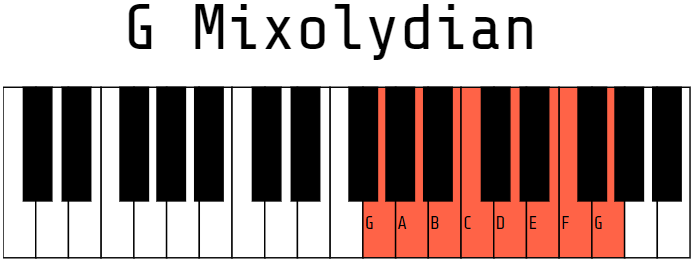Mixolydian scale (Mixoydian mode)
Mixolydian Mode Scale
The Mixolydian mode is a musical scale that is often associated with a dominant sound. It has a unique characteristic: a lowered seventh degree compared to the major scale.
The formula for the Mixolydian mode scale is: T - T - S - T - T - S - T
- Start on any note (tonic)
- Move up a whole step (T)
- Move up a whole step (T)
- Move up a half step (S)
- Move up a whole step (T)
- Move up a whole step (T)
- Move up a half step (S)
- Move up a whole step (T)
For example, if we start on the note G, applying the formula gives us the G Mixolydian mode scale:
- G - A - B - C - D - E - F - G
The Mixolydian mode is often used in blues, rock, and various other genres. It has a distinct sound and is characterized by its dominant seventh chord quality.

Mixolydian Mode Characteristics
The Mixolydian mode is a unique scale that stands out due to its distinctive interval pattern and the particular mood it creates.
Here are a few key aspects that make the Mixolydian mode special and differentiate it from other scales:
- Lowered 7th Degree: The Mixolydian mode is characterized by its lowered seventh degree, giving it a dominant sound and flavor.
- Dominant Quality: The Mixolydian mode is often associated with dominant seventh chords, creating a bluesy and rock-oriented tonality.
- Blues and Rock Music: The Mixolydian mode is commonly used in blues and rock genres, providing a strong and groovy foundation for melodies and improvisations.
- Modal Interchange: The Mixolydian mode can be effectively combined with other modes and scales, allowing for harmonic variety and interesting chord progressions.
- Open and Resolving Sound: The Mixolydian mode has a characteristic openness and resolution when used in melodic lines or harmonies.
This mode has a mellow, relaxing sound and the lowered seventh degree loses the strong sense of resolution to the tonic like in the major scale.
Overall, the Mixolydian mode's unique qualities make it a popular choice for musicians and composers looking to create energetic, bluesy, and rock-infused musical passages.
Famous Songs in Mixolydian Mode
Here are a few examples of famous songs that utilize the Mixolydian mode:
- "Sweet Home Alabama" - Lynyrd Skynyrd
- "Clocks" - Coldplay
- "Sweet Child O’ Mine" - Guns N' Roses
- "Norwegian Wood (This Bird Has Flown)" - Lennon/McCartney
- "Bitter Sweet Symphony" - The Verve
These songs incorporate elements of the Mixolydian mode in their melodies, chord progressions, or improvisations, exemplifying the distinctive sound and character of the Mixolydian mode.
Keep in mind that the Mixolydian mode might be present in certain sections of these songs or used as a basis for improvisation, rather than being the entire composition.
Chords in G Mixolydian Mode
Triads:
- G (G major): G - B - D
- Am (A minor): A - C - E
- Bdim (B diminished): B - D - F
- C (C major): C - E - G
- Dm (D minor): D - F - A
- Em (E minor): E - G - B
- F (F major): F - A - C
Quadriads:
- G7 (G dominant 7): G - B - D - F
- Am7 (A minor 7): A - C - E - G
- Bm7b5 (B half-diminished 7): B - D - F - A
- Cmaj7 (C major 7): C - E - G - B
- Dm7 (D minor 7): D - F - A - C
- Em7 (E minor 7): E - G - B - D
- Fmaj7 (F major 7): F - A - C - E
These chords are derived by stacking thirds (either major or minor) on each degree of the G Mixolydian mode. The resulting triads consist of three notes, while the quadriads consist of four notes.
Feel free to experiment with these chords to create chord progressions or use them as a starting point for your musical compositions.